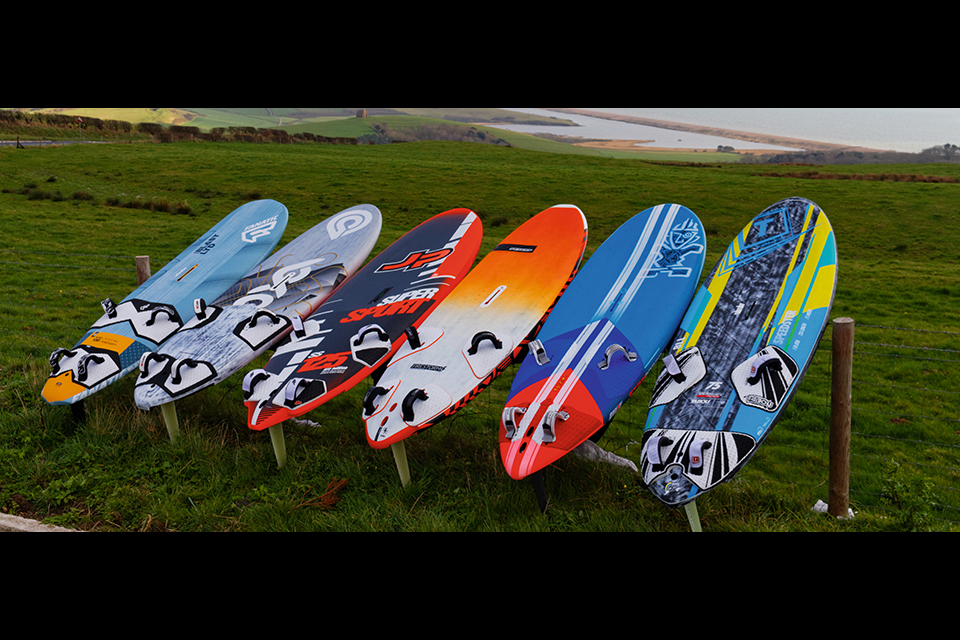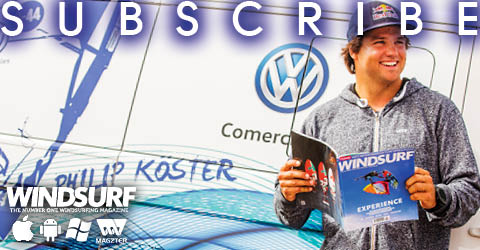EXPLORING ADVENTURE HORIZONS
120L FREERACE BOARD TEST 2017
Test Editor Tris Best // Second Testers Maurin Rottenwalter,
Joe North & Pete Young
Photos Alex Best // Test location Portland Harbour, Dorset
Freerace was a natural evolution of the freeride phenomenon, filling the gap … the void even … between the passive and the power-hungry. Freeride is and will always be known as the foundation of the windsurfing marketplace. It was the much needed solution way back when the equipment scene was becoming way too specialist and niche. Yet dumb something down too much to make it accessible and it saps the enjoyment. Freerace was the answer for the “weekend racer” – the amateur speed freak that was enthusiasm-rich, yet time-poor; for those that had reached a high sailing-standard and wanted as much enjoyment as possible in the limited time they could get on the water. Less tweaking and fine-tuning; more time blasting and drag racing their peers. And when the decision was collectively taken by all brands to supply slalom boards without fins, the freerace option all of a sudden represented excellent value for money over their slalom counterparts.
This test was originally published in the May 2017 issue.
Time moves on and so do concepts within the industry. For example, there has been a general consensus amongst sail brands in the last few years that making power delivery more progressive and forgiving is good for everyone, from beginner to pro … and the same can be said amongst the board brands as well. Control is the key. If you can retain control through a wide wind range, it is likely that the rider will feel more confident to keep the hammer down, carve tighter or hit a ramp faster. They will also be able to sail longer and ultimately have more enjoyment on the water. So for the freerace category it is all about positioning the board correctly on the speed / control spectrum and achieving the correct balance between the two qualities. You could even argue it is about establishing the correct ‘sensation’ of speed – keeping it exciting and ‘on edge’ when you’re actually in control at all times.
Logic would state that with a board sitting high, on top of the water’s surface and ‘flying’ on its fin, it generates less friction and is therefore faster. If this were true then it would surely follow that the new and exciting world of foil windsurfing (with the board sitting completely clear of the water) will take speed and slalom racing to new heights. But this isn’t the case (yet…). The reason is that wind range and sailing conditions also need to be accounted for. In light winds, foils are quite rightly attracting lots of attention, providing a planing sensation in wind strengths that would normally be dismissed as the sole domain for Formula kit. But as the wind increases and sea state becomes corrugated, most foils start to become a handful, their comparative speed being less than most ‘average’ freeride sailors are capable of. Control is paramount, and having a planted hull that remains easy to trim flat to the water’s surface will ultimately win out.
The board shaper of every brand here is more than capable of designing a fast board; the question is how to build in that element of control? The obvious solution is to adjust the rider’s position on the board. Move the footstraps more inboard and the ability to control the board through heel and toe pressure becomes easier. Many of the brands use a scooped deck shape to drop the position of the third point of contact with the board (the mast-foot) helping to keep the board pinned down. Goya have gone a step further, moving the position of the fin forward in the hull and even putting the smallest hint of tail rocker in the board to aid traction and response. We then have Fanatic, who have approached the ‘freerace’ question from a very different direction. Their argument is that the control in their slalom program has been addressed, making it accessible for riders that would have previously considered a freerace platform. So combining their knowledge of high-end performance and their new ‘stubby’ concept, they have developed the Blast – a board series that they are keen to categorise as ‘performance freeride’ instead of freerace. The hole in the market has changed in their eyes, the Blast providing an emphasis on user-friendliness and practicality to compliment the Gecko, with extra straight-line speed on tap. Be that as it is, wherever the proposals sit on the speed-control spectrum, we can all agree that it remains a very important and relevant sector of the market. Charging across the water from A to B and throwing in a gybe at the end is where we all started our planing addiction and remains one of the most fun aspects of the sport. If we can increase the wind range in which we experience the sensation and get that buzz more often, then all the better.
SUMMARY
Having tested this category for a number of years now, the first thing to highlight is that all the boards on test here are performers. In the right hands, they could all win races. Let’s start with those that have a ‘classic’ freerace feel and have had little or no change to their designs in the last twelve months. The Tabou Speedster and RRD Firestorm ride high on the surface of the water and provide direct connection with the fin as you’d expect. Their footstrap settings can be altered to vary control levels and feel, and they both demand positive input from the rider to get the most from the gybe. The difference between the two is that the Speedster is looser and livelier, whilst the Firestorm smoother and more forgiving. The Fanatic Blast sits in the group as the near freeride option, with a surprising turn of speed to keep up with most and stunning gybing ease, whilst the JP sits at the other end of the scale – a nigh-on slalom contender, its ride is sharp and instantaneous, requiring a proactive attitude to really tap into its credentials. That leaves the Starboard Futura – a board with an outline that perhaps requires a bit of getting used to, but has masses of control and range to explore. And last but by no means least is the Goya Bolt – a fantastic all round performer, that covers vast distances with ease and has a foot in both camps, offering freeride familiarity and comfort with a lively slalom-esque alertness. Call it what you will, the premise of freerace is certainly alive and well.
THE LINE UP


